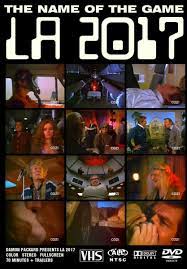Glen Howard (Gene Barry), who owns Howard Publications, is coming back from the Sierra Pines Summit meeting on pollution when he passes out at the wheel of his car. When he wakes up, he is in the year 2017. Los Angeles is underground because the air is toxic. The city has been underground since 1989. Glen is taken to see the Vice President of Los Angeles, Dane Bigelow (Barry Sullivan).
Glen learns that, when the planet experienced an ecological disaster, the population of the world was decimated. The government collapsed and corporations took over. The people that survived went underground. Life on the surface is impossible due to the poisoned atmosphere. In Los Angeles the population is approximately 10,000. Each city is run by a Vice President. The police force is all psychiatrists. Life is a dystopian fascist existence run by corporation shareholders.
When the government learns who Glen is, they want to have him start his magazine again. They plan on using it as propaganda to keep the citizens in Los Angeles in line. They further plan on expanding the magazine to the other cities. Glen isn’t happy when he learns that he is being monitored by the government. Then he finds out that the corporations are still polluting the planet surface. He refuses to go along with the plan which puts his life in danger.
“LA 2017” was released in 1971 and was directed by Steven Spielberg. It is a made of TV science fiction film and was originally shown as episode 16, season 3 of the NBC television series “The Name of the Game”. The series was based on the magazine business and featured rotating leading actors Gene Barry, Robert Stack and Tony Franciosa. The episode was written by Philip Wylie.
This is not exactly Spielberg’s best. “The Name of the Game” was a television drama so this particular episode being a science fiction story is what makes it different. The ending may not have been innovative, but the movie had to conform to the confines of the television series. The series takes place current day, which means in the 70’s, so an episode in the future has a limited way it could end. Glen would either have to find a way back to the present through another time warp or the entire episode would have to be a dream sequence. Based on the limitations of the series the episode works but as a standalone film, it has a lot of shortcomings.
On the plus side, Spielberg shot some of the surface scenes in an area that had recently been destroyed by a wildfire and he used tinted filters to give these scenes a more desolate look. Underground scenes are stark and claustrophobic. There are a few shots that show what would eventual become some of Spielberg’s signature touches. There is also a chilling closing scene that says a lot more about the theme of the episode than half the dialogue did.
There are also some strange peccadilloes. Milk is a luxury and people with status own a share of a cow. Because of changes in body chemistry people get drunk on milk. The police are all psychiatrists. A nightclub features geriatric rock and roll groups (this one seems to have come true). People are often sterilized, and babies are examined genetically. Any defective babies are destroyed. The population is monitored closely. The American cities are at war with England.


